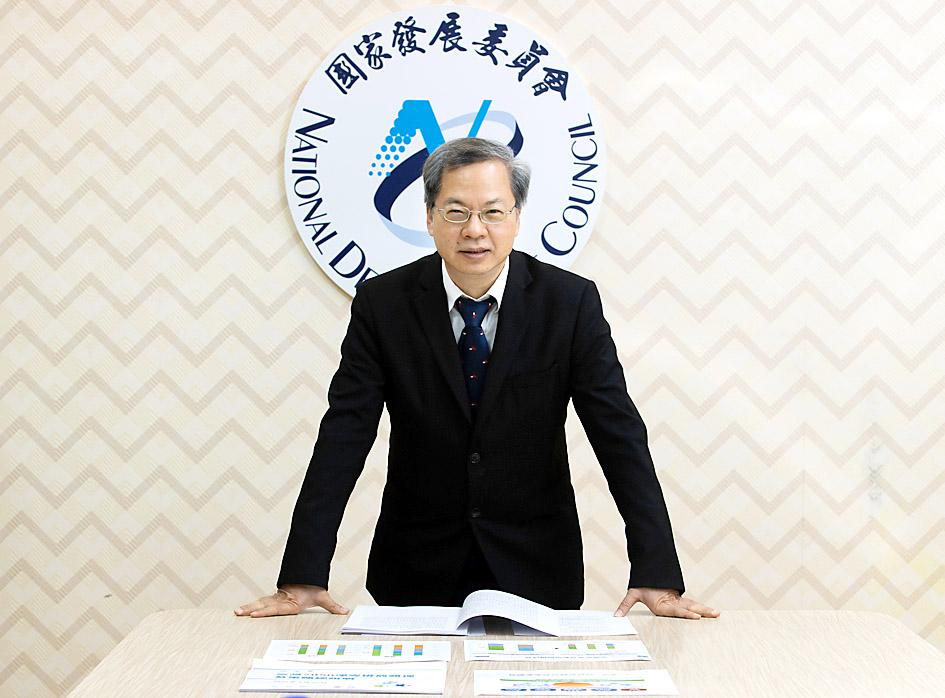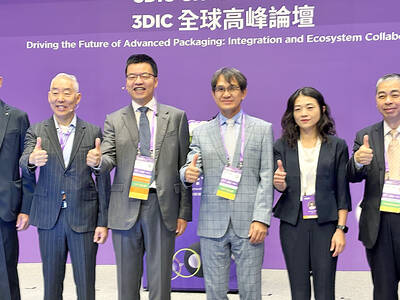Taiwan would continue to enhance its role in global supply chains in a bid to join the US-led Indo-Pacific Economic Framework (IPEF), National Development Council Minister Kung Ming-hsin (龔明鑫) said.
In an interview with Voice of America, Kung said that global supply chains have undergone a restructuring amid US-China trade tensions and the COVID-19 pandemic.
Many Taiwanese companies have remained resilient during the restructuring, Kung said, adding that they benefited from the changes and ensured Taiwan’s economic growth.

Photo: CNA
The nation’s economy last year grew 6.57 percent and is expected to grow 3.91 percent this year, he said.
Taiwanese firms have been moving their production from China to Southeast Asia, North America, and central and eastern Europe, he said, adding that the changes are expected to bolster global supply chains.
Taiwan has become a role model in the global supply chain, and it will continue to bolster the resilience of its investors and strengthen their role in global supply chains, Kung said.
Taiwan is qualified to join the IPEF, he added.
The White House on May 22 announced that Taiwan had not been invited to join the IPEF, which was unveiled by US President Joe Biden a day later during his visit to Asia.
In the first round, 13 economies accounting for about 40 percent of the world’s GDP joined the trade pact: the US, Japan, Australia, New Zealand, Brunei, India, Indonesia, South Korea, Malaysia, the Philippines, Singapore, Thailand and Vietnam.
US National Security Adviser Jake Sullivan said Washington was looking to deepen its economic relationship with Taipei, in particular on “high-technology issues, including on semiconductors and supply chains.”
The IPEF focuses on four major themes: fair and resilient trade, supply chain resilience, infrastructure, clean energy and decarbonization, and tax and anti-corruption, with further details expected later.
Despite a lack of detail, Kung said the IPEF expresses the US’ intention to return to Asia by mapping out a strategy in the Indo-Pacific region.
Taiwan has already been working to improve its performance in the four areas identified by the IPEF, he said.
Based on the IPEF’s themes, Taiwan would promote building smart cities, improve cross-border privacy and endeavor to achieve net-zero carbon emissions by 2025, he added.
However, the nation cannot develop supply chains and enter new markets on its own, Kung said.
It has to cooperate with other nations, which is why Taipei is keen to seek bilateral or multilateral cooperation in global trade, he said.
Taipei and Washington resumed talks under the Trade and Investment Framework Agreement mechanism last year after a five-year hiatus.
Both sides have also hosted digital economic forums, Kung said.
Taiwan has also begun conducting closer economic exchanges with central and eastern Europe, he said.

SEMICONDUCTOR SERVICES: A company executive said that Taiwanese firms must think about how to participate in global supply chains and lift their competitiveness Taiwan Semiconductor Manufacturing Co (TSMC, 台積電) yesterday said it expects to launch its first multifunctional service center in Pingtung County in the middle of 2027, in a bid to foster a resilient high-tech facility construction ecosystem. TSMC broached the idea of creating a center two or three years ago when it started building new manufacturing capacity in the US and Japan, the company said. The center, dubbed an “ecosystem park,” would assist local manufacturing facility construction partners to upgrade their capabilities and secure more deals from other global chipmakers such as Intel Corp, Micron Technology Inc and Infineon Technologies AG, TSMC said. It

EXPORT GROWTH: The AI boom has shortened chip cycles to just one year, putting pressure on chipmakers to accelerate development and expand packaging capacity Developing a localized supply chain for advanced packaging equipment is critical for keeping pace with customers’ increasingly shrinking time-to-market cycles for new artificial intelligence (AI) chips, Taiwan Semiconductor Manufacturing Co (TSMC, 台積電) said yesterday. Spurred on by the AI revolution, customers are accelerating product upgrades to nearly every year, compared with the two to three-year development cadence in the past, TSMC vice president of advanced packaging technology and service Jun He (何軍) said at a 3D IC Global Summit organized by SEMI in Taipei. These shortened cycles put heavy pressure on chipmakers, as the entire process — from chip design to mass

Germany is to establish its first-ever national pavilion at Semicon Taiwan, which starts tomorrow in Taipei, as the country looks to raise its profile and deepen semiconductor ties with Taiwan as global chip demand accelerates. Martin Mayer, a semiconductor investment expert at Germany Trade & Invest (GTAI), Germany’s international economic promotion agency, said before leaving for Taiwan that the nation is a crucial partner in developing Germany’s semiconductor ecosystem. Germany’s debut at the international semiconductor exhibition in Taipei aims to “show presence” and signal its commitment to semiconductors, while building trust with Taiwanese companies, government and industry associations, he said. “The best outcome

People walk past advertising for a Syensqo chip at the Semicon Taiwan exhibition in Taipei yesterday.